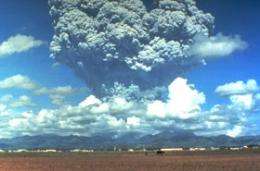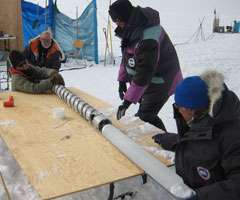Previously Unknown Volcanic Eruption Helped Trigger Cold Decade

(PhysOrg.com) -- A team of chemists from the U.S. and France has found compelling evidence of a previously undocumented large volcanic eruption that occurred exactly 200 years ago, in 1809.
The discovery, published online this week in the scientific journal Geophysical Research Letters, offers an explanation as to why the decade from 1810 to 1819 is regarded by scientists as the coldest on record for the past 500 years.
“We’ve never seen any evidence of this eruption in Greenland that corresponds to a simultaneous explosion recorded in Antarctica before in the glacial record,” said Mark Thiemens, Dean of the Division of Physical Sciences at UC San Diego and one of the co-authors of the study. “But if you look at the size of the signal we found in the ice cores, it had to be huge. It was bigger than the 1991 eruption of Mount Pinatubo in the Philippines, which killed hundreds of people and affected climate around the world.”
Led by a chemist from South Dakota State University, the team of scientists made its discovery after analyzing chemicals in ice samples from Antarctica and Greenland in the Arctic, where the scientists visited and drilled ice cores three years ago. The year-by-year accumulation of snow in the polar ice sheets records what is going on in the atmosphere.
“We found large amount of volcanic sulfuric acid in the snow layers of 1809 and 1810 in both Greenland and Antarctica,” said professor Jihong Cole-Dai of SDSU’s Department of Chemistry and Biochemistry, who was the lead author of the paper.
Joël Savarino of the Laboratoire de Glaciologie et Géophysique de l’Environment in Grenoble, France, and a former postdoctoral fellow at UC San Diego, was also part of the team.

Cole-Dai said climate records show that not only were 1816 — the so-called “year without a summer”— and the following years very cold, the entire decade from 1810 to 1819 was probably the coldest for at least the past 500 years.
Scientists have long been aware that the massive and violent eruption in 1815 of an Indonesian volcano called Tambora, which killed more than 88,000 people in Indonesia, had caused the worldwide cold weather in 1816 and after. Volcanic eruptions have a cooling effect on the planet because they release sulfur gases into the atmosphere that form sulfuric acid aerosols that block sunlight. But the cold temperatures in the early part of the decade, before that eruption, suggest Tambora alone could not have caused the climatic changes of the decade.
“Our new evidence is that the volcanic sulfuric acid came down at the opposite poles at precisely the same time, and this means that the sulfate is from a single large eruption of a volcano in 1809,” Cole-Dai said. “The Tambora eruption and the undocumented 1809 eruption are together responsible for the unusually cold decade.”
Cole-Dai said the Tambora eruption was immense, sending about 100 million tons of sulfur gas into the atmosphere, but the ice core samples suggests the 1809 eruption was also very large — perhaps half the size of Tambora — and would also have cooled the earth for a few years. The researchers reason that, because the sulfuric acid is found in the ice from both polar regions, the eruption probably occurred in the tropics, as Tambora did, where wind patterns could carry volcanic material to the entire world, including both poles.
Cole-Dai said the research specifically looked for and found a special indicator of sulfuric acid produced from the volcanic sulfur gas in the stratosphere.
The special indicator is an unusual make-up of sulfur isotopes in the volcanic sulfuric acid. Isotopes are different types of atoms of the same chemical element, each having a different number of neutrons (but the same number of protons). The unique sulfur isotope composition is like a fingerprint of volcanic material that has reached the stratosphere, said Cole-Dai.
The stratosphere is the second major layer of the Earth’s atmosphere, reaching from about six miles to about 30 miles above the Earth’s surface at moderate latitudes. To impact global climate, rather than local weather, the sulfur gas of a volcanic eruption has to reach up into the stratosphere and once there, be spread around the globe.
“The way in which that these volcanoes affected the average temperatures of our planet gives us a better idea of how particulates in the atmosphere can affect our climate,” said Thiemens. “People talk about the possibility of geo-engineering our climate, but the question is how? In this case, nature has done an experiment for us.”
Provided by University of California - San Diego (news : web)















